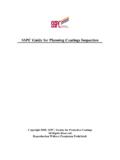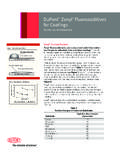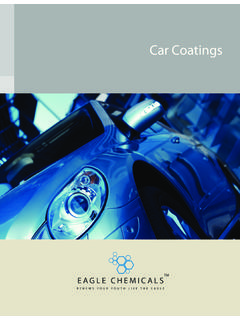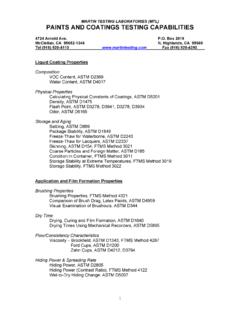Transcription of coatings for tooling - Beamalloy
1 Copyright, CSC Publishing. Tablets & Capsulescoatings for toolingIf tabletting equipment is the engine driving your manufactur-ing operation, you want to keep it running as smoothly andefficiently as possible. This article describes how specializedcoatings preserve and improve your tooling . It examines sev-eral coatings and coating methods and assesses the advantagesand disadvantages of H. DeutchmanBeamalloy TechnologiesChoosing coatings to improvethe performance of tablettoolingIndustrial processes, such as plastic molding and metalstamping, use engineered coatings to improve the perfor-mance of manufacturing tooling .
2 These same coatingscan help tabletting tools resist corrosion and slow therate at which tool surfaces degrade, thus improving prod-uct quality and manufacturing productivity. The coatingscan also improve the performance of tablet press 9/1/04 4:57 PM Page 1 Copyright, CSC Publishing. Tablets & CapsulesTo take full advantage of these coatings , it s important tounderstand the surface interactions on the tablet toolface. With this knowledge, you can choose a coating andcoating process that best meet your finish and tool performanceWhen you buy new tabletting punches from the man-ufacturer, they re free of wear and corrosion, and thepunch-cup surfaces are highly polished.
3 As these punchescompress powders into tablets, the punch cup replicatesits surface finish on each tablet. Therefore, to ensuretablet quality, you must preserve the surface finish on thepunch cup. In addition, if the punch cup surface becomesabraded, scratched, or corroded, the roughened face cantrap small powder particles, which can lead to stickingand picking 1 shows the surface profiles of the polished areason the face of new and used tablet punch cups. The profileof the polished face of the new punch with a spectral(highly reflective) finish is very smooth and shows no fea-tures deeper or wider than micron.
4 To see features thissmall requires very high magnification, 4,000 Xor you use the punch, the powder you re tablettingwill abrade the surface, and the spectral surface will even-tually appear matte. This is caused by microscopicscratches and digs in the surface that are to wide and deep. To see these requires magnifica-tion of 750 Xor more. Large, hard granules in the powderor contaminants from buffing wheels (from punch manu-facture or routine maintenance) can produce even deeperscratches. To see them requires a magnification of 500 Xor more. Surface corrosion can leave very deep pits, someof them hundreds of microns in depth.
5 It can also buildup oxide or sulfide scales on the surface. These you cansee with the naked mechanical the polishedsurfaces of the punches roughen, powders can becometrapped in mechanical surface imperfections. See Figure2. Over time, more powders will stick to these trappedparticles and will build up on the surface. Eventually,filming and sticking will appear, and you ll have to halttabletting to clean the , if the surfaces corrode and rust layers buildup on the punch surface, powders will stick to the rough-ened rust layers.
6 While detergents and solvents willremove the adhered powder, they won t restore the origi-nal finish to the punch surfaces. Instead, you may have tobuff out the scratches, pits, and corrosion layers torestore the surface finish in the tool you have to rely on buffing andpolishing to restore worn and corroded punch faces,your efforts will become counterproductive. Buffingcompounds contain abrasives that actually remove thinlayers of the metal surface to polish out scratches andpits. Repeated buffing can reduce the critical punchdimensions in the land area the area between the edgeof the punch cup and the outside diameter of the punchtip thus degrading the fit between the punch and buffing also rapidly degrades the aspect ratiosof the embossing on the punches.
7 In short, buffing andpolishing dramatically reduce the service life of 1 Surface profiles across the faces of new and used tabletting punchesNew punchUsed punchesSurface profile(microns)Magnification requiredto see surfaceSpectral ( )4,000X(Hundreds)Scratched surface(1-10)500 XAbraded surfaceCorroded surfaceMatte ( )750 XNoneSmooth surfaced-Deutchmanart_16-27 9/1/04 4:57 PM Page 2 Copyright, CSC Publishing. Tablets & CapsulesWear and corrosiondirectly decreasetablet quality, reducetabletting productiv-ity, and increase man-ufacturing the base metalsof tabletting tools areideal for the mechani-cal demands of tablet-ting, their surfaces canbe coatings ,if chosen and appliedproperly, are an excel-lent means of improv-ing resistance to wearand requirements for tablet tool coatingsTabletting punches are precision tools, and no coatingor coating process can be allowed to compromise theiroriginal properties.
8 Table 1 lists engineering requirementsfor tablet punch coatings . To apply a coating successfully,you must be aware of these , coatings must notdegrade the original spectral finish on the cup that roughen the surface, even though theymay be hard, will promote mechanical adhesion of pow-ders to the punch. coatings must be harder than themetal used to makethe punch to bolsterwear must adherewell to the cup sur-face so that theydon t chip or coatings mustbe free of pinholesand voids to offer abarrier to , the coatingsmust be chemicallyinert to satisfy Foodand DrugAdministration(FDA) and currentGoodManufacturingPractice (cGMP) related to punch coat-ing process must not reduce the hardness of the processing temperatures can soften the punch, thusweakening such key surfaces as the land area and domedhead.
9 You must also maintain the physical dimensions ofthe punch during coating . Excess heat can easily distortkey dimensions, such as overall length, so that theyexceed critical tolerances. Certain plating processesapply coatings non-uniformly, leaving too thick a coat-ing on sharp land edges and on the 1 Engineering requirements for tablet punch coatingsSurface-related propertiesBenefitsNon-degraded surface finish in cupNo mechanical interlocking of powderIncreased surface hardnessImproved wear resistanceGood coating adhesionNo flaking or chippingNo pits or voids in the coatingContinuous corrosion barrierChemically inert coatingMeets FDA and cGMP guidelinesBulk-related propertiesHardness of barrelNo tempering or softeningOverall dimensionsNo distortionLand areaNo asymmetric buildupFigure 2 Powder entrapment on
10 Punch cup surfacesRoughened punch face surfaced-Deutchmanart_16-27 9/1/04 4:57 PM Page 3 Copyright, CSC Publishing. Tablets & CapsulesCoating processesOf the many coating processes in the industrial mar-ketplace, three are commonly used on tablet tooling :1. Chemical plating2. Physical vapor deposition (PVD)3. Ion-beam-enhanced deposition (IBED)All the available coatings are deposited by one ofthese three basic processes. Metallic coatings , such asnickel (Ni) and chromium (Cr), are deposited either byelectroless electroplating (Ni) or electroplating (Cr).






